
Louise Cash Oddenino's great-grandfather was John Madison Cook
who was a Confederate veteran.
Here is the only photo we have of John Madison
Cook:
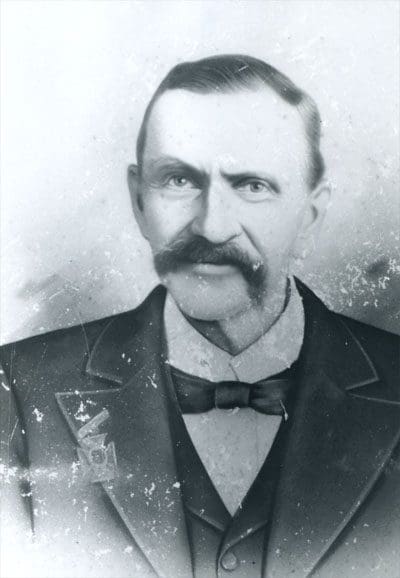
And the only known image of his wife, Martha Frances
Ford:
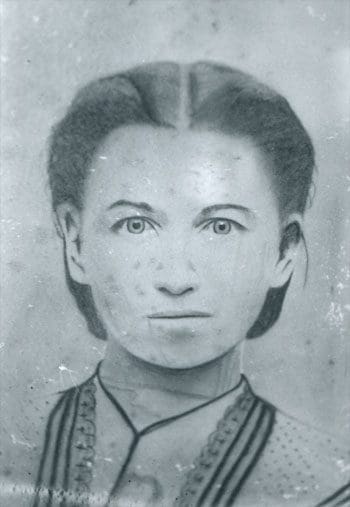
Here is John Madison Cook's marriage documents for his marriage to Martha Frances
Ford before he joined the Confederate Army:
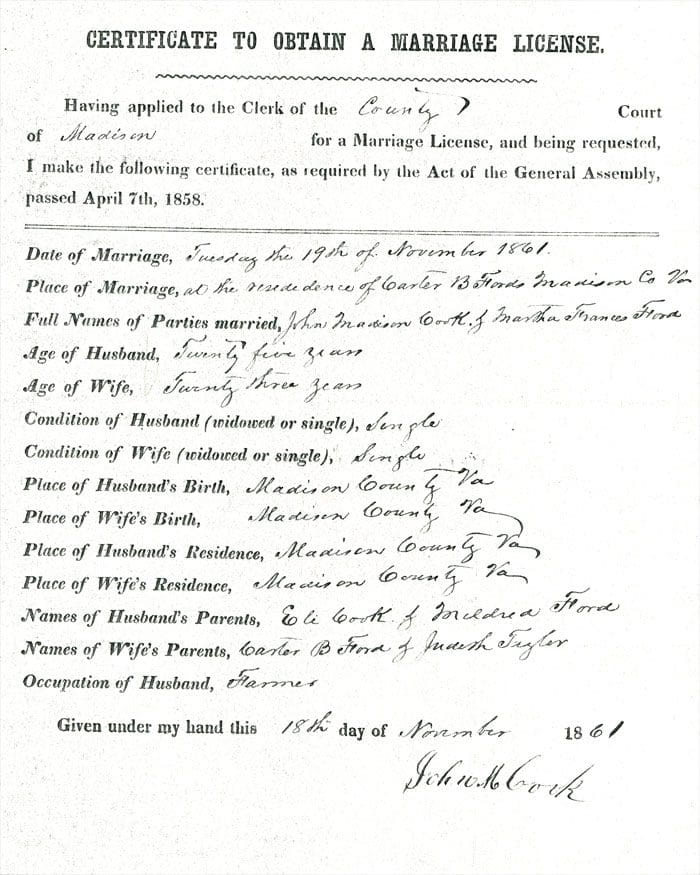
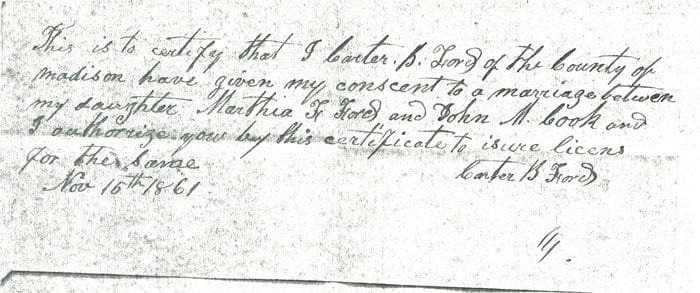
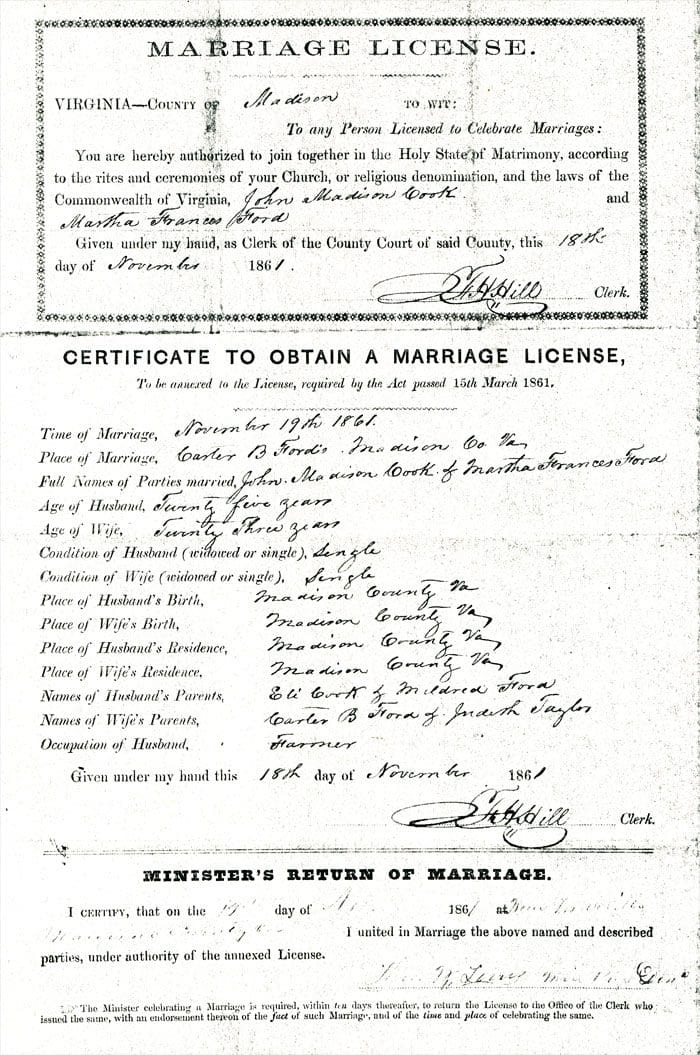
Like his fellow Madison County citizen, John J. Seal, John Madison Cook was a
member of Company C of the 4th Virginia Cavalry.
The 4th Virginia Cavalry was under the general command of J.E.B. Stuart:
CAVALRY DIVISION
Maj. General James E. B. Stuart
Fitz Lee's Brigade- Brig. General W. Fitzhugh Lee
1st Virginia Cavalry- Col. James H. Drake
1st Maryland Battalion- Maj. Harry Gilmore; Maj. Ridgely Brown
2nd Virginia Cavalry- Col. Thomas T. Munford
3rd Virginia Cavalry- Col. Thomas H. Owen
4th Virginia Cavalry- Col. William Carter Wickham
Here is an excerpt from the Wikipedia account of Col. Wickham's Civil War service :
Following the secession of Virginia, Wickham took his company, the Hanover Dragoons, into the service of the Confederate States Army. After participating in the First Battle of Manassas, Wickham was commissioned by Governor John Letcher as lieutenant colonel of the Fourth Virginia Cavalry in September 1861. On May 4, 1862, he incurred a severe saber wound during a cavalry charge at the Battle of Williamsburg. In this state of injury, he was captured, but quickly paroled. In August 1862, he was commissioned Colonel of the Fourth Virginia Cavalry. At the Battle of Sharpsburg, he was wounded again, this time in the neck by a shell fragment. Recovering, he participated in the battles of Chancellorsville and Gettysburg.
Wickham was commissioned brigadier general on September 9, 1863, and put in command of Wickham's brigade of Fitzhugh Lee's division. On May 11, 1864, he fought at the Battle of Yellow Tavern. Maj. Gen. J.E.B. Stuart was mortally wounded during this engagement, with his final order being: "Order Wickham to dismount his brigade and attack." In September 1864, after the Confederate defeat at the Battle of Fisher's Hill, Wickham blocked at Milford an attempt by Maj. Gen. Philip Sheridan to encircle and destroy the Confederate forces of Maj. Gen. Jubal Anderson Early. He then attacked the Federal cavalry at Waynesboro and forced them to retreat to Bridgewater.
Wickham resigned his commission on October 5, 1864, and took his seat in the Second Confederate Congress, to which he had been elected while in the field. Recognizing that the days of the Confederacy were over, he participated in the Hampton Roads Conference in an attempt to bring an early end to the war.
The National Park Service provides a valuable web site on Civil War veterans and
here is what they say about the 4th Regiment, Virginia Cavalry unit:
4th Regiment, Virginia Cavalry
4th Cavalry Regiment completed its organization at Sangster's Cross Roads, Prince William County, Virginia, in September, 1861. Its members were recruited in the counties of Prince William, Chesterfield, Madison, Culpeper, Powhatan, Gouchland, Hanover, Fauquier, Buckingham, and the city of Richmond. The unit was assigned to General J.E.B. Stuart's, F.Lee's, Wickham's, and Munford's Brigade, Army of Northern Virginia. It participated in the Battle of Williamsburg, the Seven Days' Battles, and the Second Manassas and Maryland campaigns. Later the unit was involved in the conflicts at Fredericksburg, Kelly's Ford, Chancellorsville, Brandy Station, Upperville, Gettysburg, Bristoe, Mine Run, The Wilderness, Todd's Tavern, Spotsylvania, Haw's Shop, and Bethesda Church. The 4th went on to fight in the Shenandoah Valley with Early and around Appomattox. It totalled 450 effectives in April, 1862, and lost about three percent of the 544 engaged at Gettysburg. After cutting through the Federal lines at Appomattox, it was broken up. Only 2 members were present at the surrender. The field officers were Colonels Stephen D. Lee, William H. Payne, Beverly H. Robertson, William C. Wickham, and W.B. Wooldridge; Lieutenant Colonels Charles Old and Robert Randolph; and Majors Alexander M. Hobson and Robert E. Utterback.
Click here to search for soldiers in this unit.
From the Virginia Regimental Histories Series we look to Kenneth Stiles work on
the 4th Virginia Cavalry for a view of this unit:
On The Frontier — 1861
The 4th Regiment Virginia Cavalry has been described as one of the most distinguished cavalry commands in the Confederate service. The unit participated in every major battle and campaign which involved the Army of Northern Virginia and produced three brigadier generals. A fourth would have risen from the ranks had the war not ended abruptly in April of 1865. The regiment rode and fought for Virginia and the Confederacy from before First Manassas to the last charge from Appomattox Court House up the Lynchburg road where the unit disbanded, never handing over its colors, nor stacking its arms in submission.
Ten companies composed the 4th. Chesterfield County's company was organized in 1851. Four companies from Goochland, Hanover, Warrenton and Richmond came into being in the latter part of 1859 during the John Brown excitement. That raid in October of 1859 was the driving factor behind the organization of the cavalry units from Prince William, Madison and Powhatan counties as well. The last company to join the 4th was from Buckingham and was formed in March of 1862 for three years of Confederate service. The companies were:
Company A Prince William Cavalry
Company B Chesterfield Light Dragoons
Company C Madison Invincibles
Company D Little Fork Rangers (Culpeper)
Company E Powhatan Troop
Company F Goochland Light Dragoons
Company G Hanover Light Dragoons
Company H Black Horse Troop (Warrenton)
Company I Governor's Mounted Guard (Richmond)
Company J Philip McKinney's Company (Buckingham)
Additional commentary from this text by Kenneth Stiles provides some insight into
the hardships they experienced during the war:
At the bottom of the report, the recording officer commented on what
he thought was the reason forthe bad conditions of the 4th Regiment:
First, we have been actively engaged since the 4th of May,
1864, have been marching and countermarching, and much
exposed to stormy and rough weather, and an inadequate
amount of forage for the horses has depleted the animals
. That until now, no opportunity has been offered to
reorganize, and the heavy loss of officers killed and wounded
in Battle, and by sickness from exposure is the prime cause.Second,
We have been compelled to send the sick and wounded "back to
[the] rear" and the Surgeon has scattered the men to the four winds.
This account of the 4th Virginia's condition told the story better than anything else could. And it mirrored the rest of the division rather well too.Though beaten into weariness by both battle and Mother Nature, the soldiers still held on.
By March 2, Fitz Lee's division was ordered to regroup. The following week, the cavalry moved farther up the James River because a "want offorage and provisions" paralyzed the force while it remained near Richmond.
The lack of food for the cavalry persisted as Fitz Lee crossed the James River and moved to High Bridge near Farmville on March 8. With aterrible rain darkening the skies that Wednesday night, some in the brigade joked about having to learn "Yankee Doodle" and the "Star Spangled Banner" again.
FAMILY STORIES ABOUT THE CIVIL WAR AND THE COOKS
On May 4, 1977 I had the pleasure of discussing the family history of John Madison Cook with one of his great-granddaughters, Eppa Roberts (Eppa's mother was Ada Cook Roberts, daughter of John Madison Cook and Martha Frances Ford). She shared with me the following story that had been told to her by her mother:
While John M. Cook was away at "that war" (actual quote) some Yankees came to their house and stole chickens, turkeys and even stuffed feathers in their molasses to starve them because Martha's husband was a reb. The Yankees stole all the food in the house even the butter. Martha asked the Yankees to leave some butter because she had a sick child who would only eat bread and butter. One of the Yankees told the others to give her a little butter back and they did.
Eppa Roberts also informed me that John M. Cook was known for blackening his moustache as he got older and that he was a good farmer. She said she thought John M. Cook had a sister named Ann Cook who married Howard Huffman and they had six children named Robert, Rosa, Myrtle, Lena, Hamp, and Holland.
She said that there is a family burial ground near Leola Frye's place by Ford's shop and the graveyard is between Ford's place and Leola Frye's place.
Eppa Roberts said that Martha Ford Cook had health problems after the Civil War and she was an invalid before she died leaving seven children, Anna (who married Lee Jackson Brown), Edie, Lizzie, Ada, Liza, Hugh and Calvin. John M. Cook married his second wife, Virginia Aylor, on February 18, 1897 by whom he had children named, Dewey, Silas, Stuart, Lucian and Lucy.
CONFEDERATE PENSION APPLICATIONS
Not surprisingly, the federal government did not provide pension assistance for Confederate veterans. The Commonwealth of Virginia did pass legislation to provide state assistance for its Confederate veterans through the Virginia Confederate Pension Acts. Here is John M. Cook's application for disability assistance. Please notice line 16 where he states that his service in the Confederacy ended "when Lee surrendered." This is similar to Michael Bazzle's Confederate pension application.
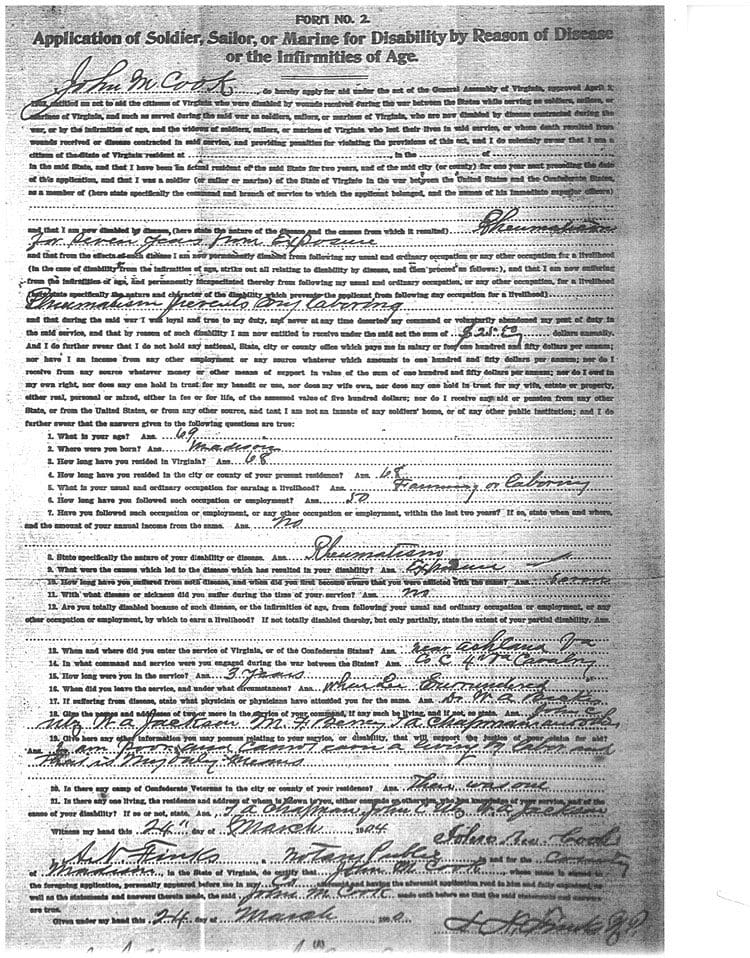
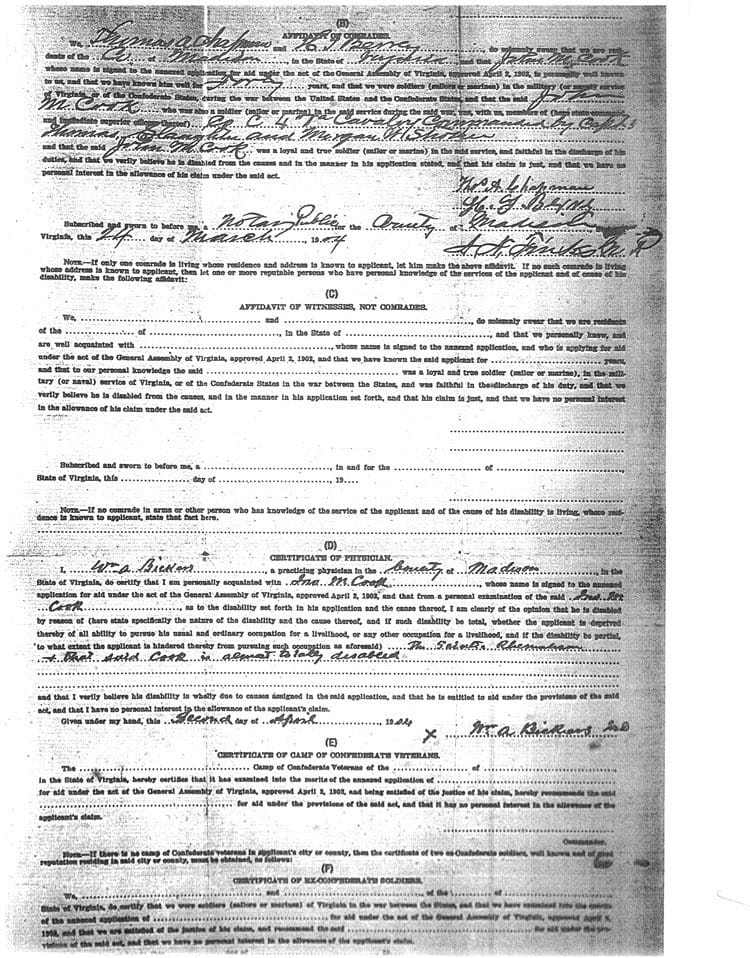

John M. Cook's second wife, Virginia Aylor, applied for widow's assistance after
John's death:
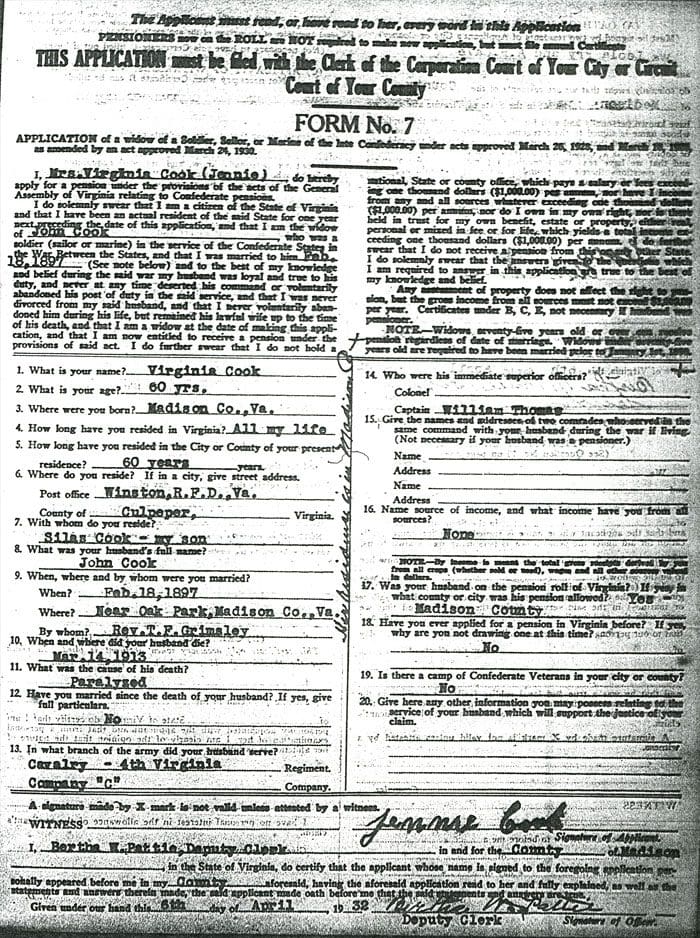
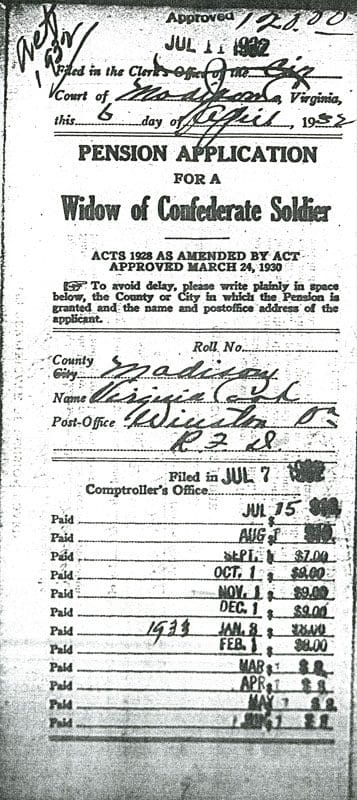
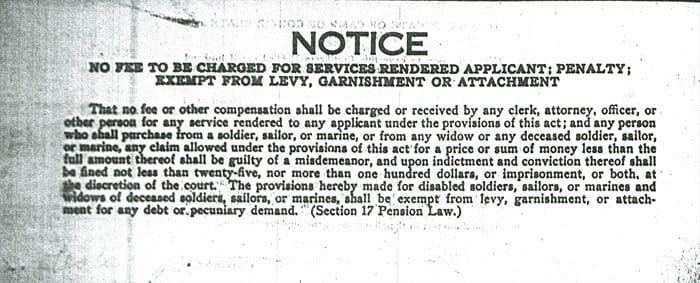
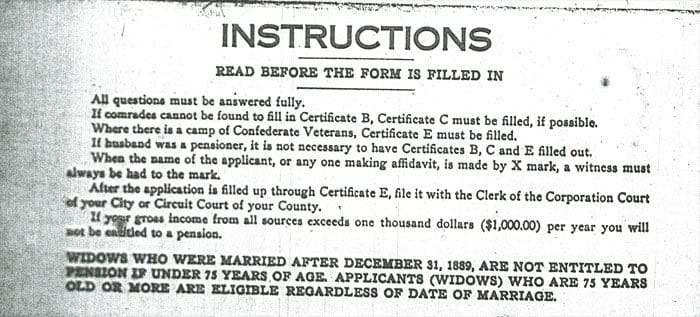
Here is the family tree chart for Elizabeth Cook, daughter of John M. Cook and
Martha Ford:
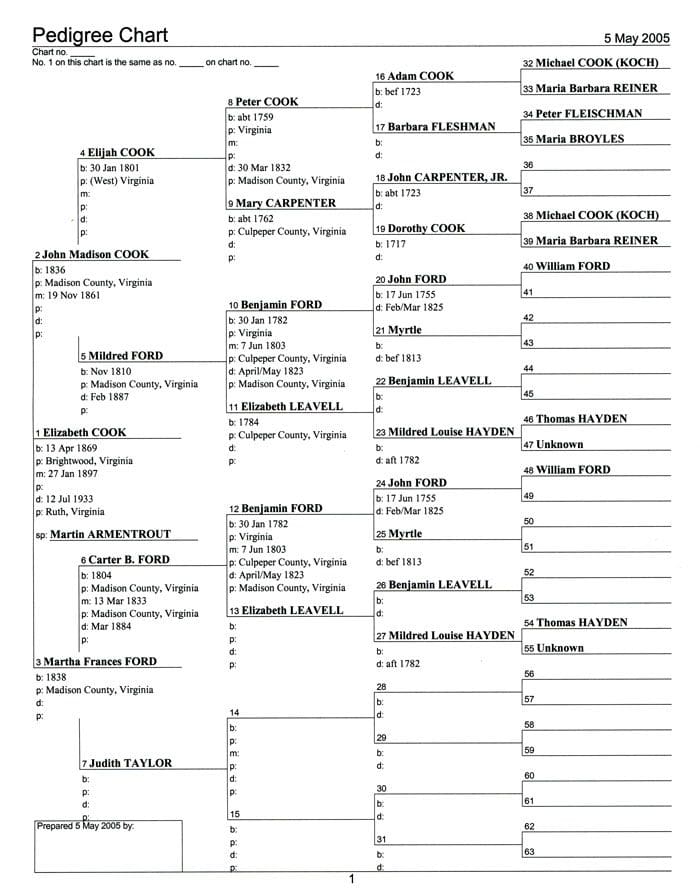
Here are the marriage records from Madison County,Virginia from February 27,
1832 for Elijah Cook and Mildred Ford. The second document is an oath from
George W. Ford attesting that his sister Mildred Ford turned 21 years of age in
November of 1831:
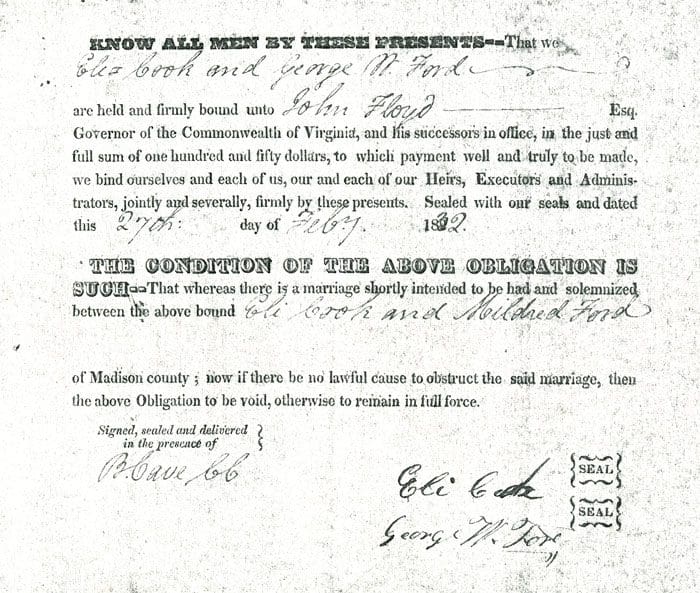
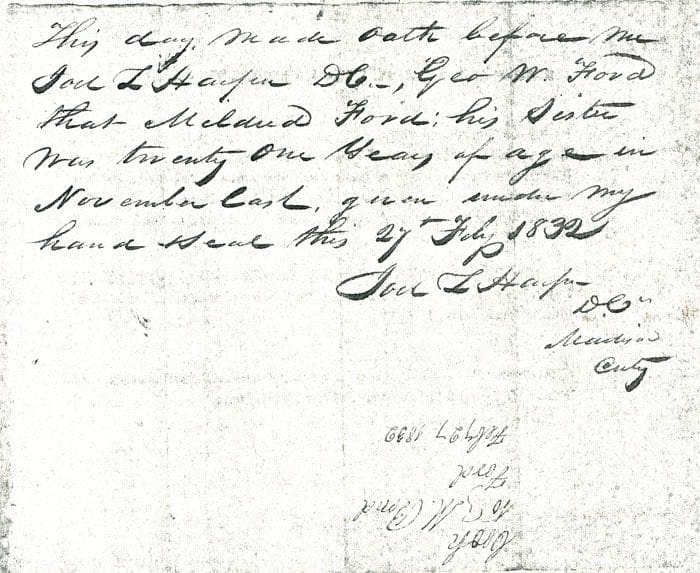
John M. Cook, was the son of Elijah Cook and Mildred Ford and a
descendant of Germanna immigrant Michael Cook.
From John Blankenbaker's Germanna Notes on the COOK family:
Nr. 344:
A reader suggests that I have not covered the Cook family who were members of the Second Colony. Let's see, if by putting our heads together, if we can't make a few statements about them. Michael Cook (Koch) was from Schwaigern, where he had married Barbara Reiner; however, in Virginia, his wife's name seems to have been Mary. Whether Barbara and Mary are the same person is not proven, but Mary does appear to be a Reiner. In fact, in the Hebron Register she is given as a "Steiner", which is surely a mistake for Reiner. Another minor mystery is why Michael Cook and Jacob Crigler had a joint patent for land.
Michael and Mary Cook had four children in Virginia: Margaret, Dorothy, Adam, and George. The Hebron Church Register has many references to the families and their members, and it is possible to state that the four children and their marriage partners were (keeping the number 1 for Michael):
George Cook, born before 1723, married first, Mary Sarah Reiner, his first cousin, and married second, Anna Maria Hoffman. He died about 1802. Mary Sarah Reiner came with her family about 1750. Her father is believed to be the brother of Michael Cook's wife.
Adam Cook, born before 1723 also, married Barbara Fleshman.
Dorothy Cook, married John Carpenter, Jr.
Margaret Cook, married Philip Snyder. She died about 1795.
I have the following grandchildren of Michael. Children of George Cook and his first wife, Mary Sarah Reiner:
1. Mary Barbara Cook, b. 1751, married John Blankenbaker.
2. Margaret Cook, b. 1753, married Christopher Tanner.
3. Magdalena Cook, b. 1756, married John Huffman.
4. Elizabeth Cook, b. 1758, d. before 1805, no marriage known.
5. Dorothy Cook, b. 1762, no marriage known.
6. Diana Cook, died at a young age.
7.Lewis Cook, b. 1768, married Mary Yager.
All of the above children birth's are in the Hebron Register. Children of George Cook and his second wife, Anna Maria Hoffman:
1. Ambrose Cook, b. 1775, married Susanna Fleshman.
2. Aaron Cook, b. 1776, married Leanna Garr.
3. Sara Cook, b. 1777, married Andrew Huffman.
4. George Cook, b. 1778, married Jemina Wilhoit.
5. Rosanna Cook, b. 1779.
6. Cornelius Cook, b. 1780, married Mary Wilkinson.
7. Moses Cook, married in 1804, Elizabeth Grayson.
8. ? Jemina ? (This may have been a daughter-in-law, not a daughter.)
Not all of the children of the second family are in Register. Another source of information on the members of the family is the estate settlement of George Cook. As we proceed with the discussion of the Cook family, perhaps readers can add or correct what is said.
Continuing with the Second Germanna Colony family of Michael Cook, some information was given in the last note about his son, George. One reason for starting with George is that the Hebron Register and the estate settlement for George (see Madison County Deed Book for 1805) specify his children, though uncertainties remain. References to other Cooks in the Hebron Register must be references to the children of Adam, if not to the sons George and Adam themselves. (Of course, the next generation could be appearing also.)
Land deeds and the Hebron references establish that Michael Cook had four children, two girls, Dorothy and Margaret, who were older than the two sons, Adam and George. On 1 Aug 1751, Michael Cook gave 100 acres each to Philip Snyder and to John Carpenter, Jr. On 21 Jul 1757, he gave 112 acres to Adam and George. This later date for the son's land is the reason for thinking that the sons were younger than the daughters. The distribution of land was typically German, with both daughters and sons receiving assets. Also, a distribution before death is not unusual.
When the final estate of George Cook, one of the sons of Michael, was divided, there were thirteen heirs who sold smaller pieces of land. Each of the heirs had a set of witnesses to the act. As a consequence, some information can be learned from the names of witnesses. For example, there were two John Blankenbakers in the community at the time. Mary Barbara Cook, the eldest daughter of George Cook, married one of them, but which one? Since the husbands signed for the couples in the estate sale, a John Blankenbaker appeared, and he asked some other Blankenbakers to be his witnesses. The logical persons to ask would be his brothers. Therefore we conclude that this John Blankenbaker was the one who was the son of Zacharias.
In a similar way, Jemina Cook had three witnesses, all different from the other witnesses. Her relationship might be as an unmarried daughter of George, or it might be as a daughter-in-law. Her witnesses were three Garr men. It is hard to escape the conclusion that Jemina was a Garr who had married a son of George who died after his father died and before the estate was settled; however, I have not researched this question in depth. (If I could find my copy of the estate settlement, I might look into this more as I now have a copy of the Garr Genealogy.

